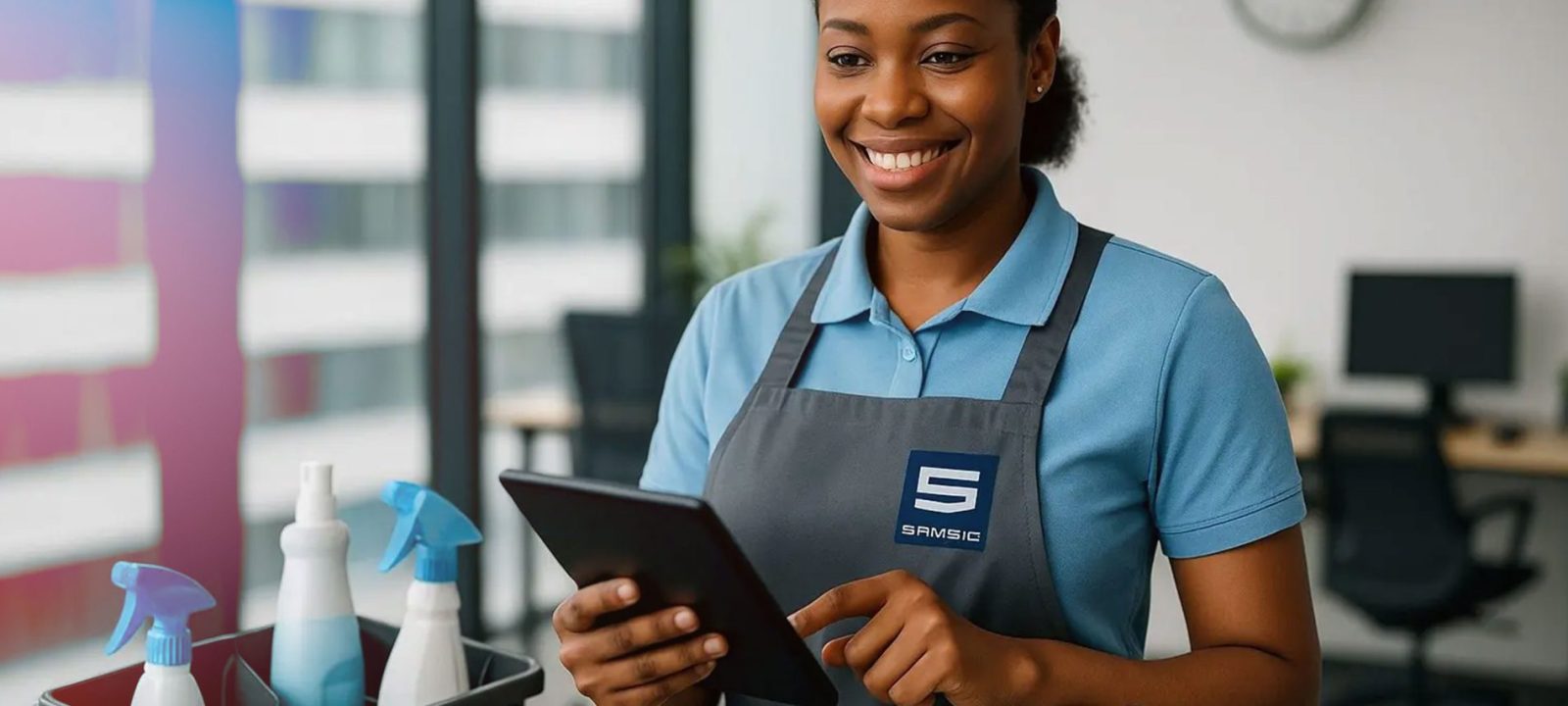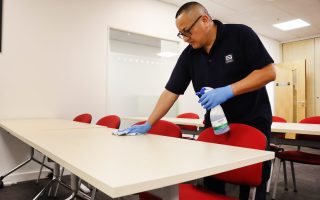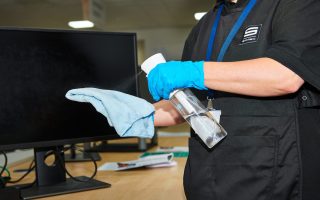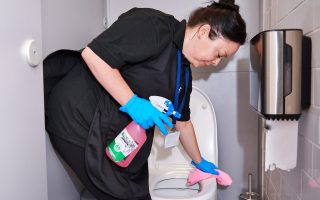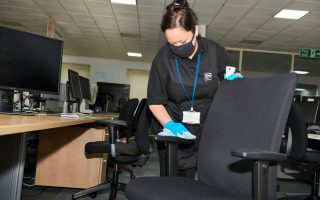Cleaning can be a hidden cost trap for many businesses. Whether you’re overseeing a corporate office, healthcare facility, or industrial site, inefficient cleaning practices can quietly erode your bottom line – without anyone noticing until it’s too late.
At Samsic UK, we understand that commercial cleaning isn’t just about hygiene – it’s about performance, compliance, and cost control. In this guide, we reveal data-backed, cost-saving cleaning strategies to help you:
- Cut waste and overheads
- Streamline operations with smart technology
- Improve service quality without increasing spend
If you’re looking to reduce cleaning expenses without compromising standards, these are the strategies you need.
Quick Summary of the Best Strategies to Reduce Cleaning Costs
- Audit your cleaning service: Identify inefficiencies to implement cost-saving cleaning strategies and reduce cleaning expenses.
- Optimise schedules: Match cleaning frequency to actual need for efficient cleaning services and cleaning cost reduction.
- Use smart cleaning tech: Automated tools and sensors drive efficient cleaning services and lower commercial cleaning costs.
- Bundle FM services: Consolidate services to streamline delivery and cut commercial cleaning costs.
- Go sustainable: Eco-friendly methods reduce waste and support cost-saving cleaning strategies.
- Track performance data: Use KPIs and insights to adjust services for ongoing cleaning cost reduction.
Why Cost-Saving Cleaning Strategies Matter for Every Business
Efficient cleaning services are essential to your business’s success. It supports employee wellbeing, protects your reputation, and ensures compliance with health and safety regulations. However, cleaning – whether handled in-house or through a contractor – can quietly become a major area of hidden expense unless handled correctly, detracting from your profit margin.
To help support your business, we’ve compiled our best-practice advice and the industry’s most effective cost-saving cleaning strategies and technologies, helping you to reduce cleaning expenses while maintaining quality and compliance across your facilities.
How to Assess and Reduce Cleaning Expenses Effectively
Before you reduce cleaning expenses, it’s crucial to understand where your money is currently being spent. A detailed assessment will help you to prioritise the improvements that will have the biggest impact.
Common Areas of Cleaning Overspend
Some of the most frequent causes of unnecessary cleaning costs include:
- Too much product usage: Over-ordering or free-pouring leads to waste and unnecessary spend.
- Inefficient cleaning schedules: Cleaning low-traffic or empty areas wastes time and resources.
- Outdated methods: Manual systems or poor-quality tools slow teams down and reduce cleaning quality whilst accruing a higher cost.
- In-house cleaning time: If your internal employees clean instead of doing their actual jobs, it affects productivity and profit and has an overall negative effect on the cleanliness of your premises.
At Samsic, we combine industry-leading research and cutting-edge technology to ensure a bespoke service tailored to each of our clients’ business needs. This service is optimised and enhanced on an ongoing basis and ensures the best level of value for every pound spent.
Conduct a Cleaning Audit for Maximum Cleaning Cost Reduction
To uncover opportunities within your business for cleaning cost reduction, first conduct a structured audit process.
Step 1: Define Audit Objectives
Whilst regular cleaning audits help assess overall service quality, they should also focus on identifying areas of inefficiency, service gaps, and areas of expense that could be amended to offer more return.
Step 2: Review Current Commercial Cleaning Costs, Contracts, and Service Agreements
If your business works with a professional cleaning supplier, we recommend assessing your existing service level agreements (SLAs) to ensure they are aligned with your business’s current needs.
- Are they cleaning areas that don’t need daily attention?
- Could they adjust cleaning frequency based on footfall?
- Are tasks duplicated or unnecessary?
- Are the products, technologies, and processes used suitable for your business or industry? Could they be better?
At Samsic, our dedicated Innovations department perform regular 360° service reviews to ensure our service is adapted to each client’s needs and business growth. For example, we often replace fixed daily schedules with demand-based cleaning strategies, delivering more efficient cleaning services that have reduced commercial cleaning costs.
Step 3: Analyse Workforce Productivity & Scheduling
Make sure your cleaning team is deployed where and when they’re needed most. Review their shift patterns and labour allocation across sites to reduce inconsistencies in quality standards, optimise coverage, and avoid under- or over-staffing.
At Samsic UK, we utilise time-tracking data to assess efficiency amongst our teams. With scheduling technology, we can accurately map each of our cleaning operatives’ areas, ensuring an even workload between all members. Additionally, we track how long each clean takes and what it consists of – driving efficiency and continuous improvement.
Step 4: Assess Cleaning Product and Equipment Usage
Overuse of chemicals or outdated tools can inflate costs, whilst too little usage could mean areas are not sanitised correctly. It may be useful to consider:
- Introducing dilution control systems – helping the right amount of product to be used throughout all cleaning activities
- Switching to sustainable multi-use or refillable solutions
- Assessing the facility itself as older, poorly maintained environments can be harder and more costly to clean
We recommend sustainable systems like Toucan Eco Active, which eliminate the need for store-bought chemicals and reduce commercial cleaning costs as the cleaning solution is generated on-site. Toucan also has huge sustainability benefits, reducing single-use plastics across site cleaning activities and eradicating the need for harsh chemicals.
Step 5: Evaluate Technology and Automation
Up-to-date technology or smart tools such as sensors can help to revolutionise your cleaning service by reducing cleaning expenses, the time taken to complete tasks, and perhaps even automating some tasks completely. Cobotics, for example, can conduct time-intensive tasks such as floor cleaning efficiently, freeing cleaning staff for more detail-focused work. IoT-enabled dispensers can track usage of paper towels and other consumables, reducing waste and eradicating unnecessary restocking or checks.
At Hurstpierpoint College, Samsic deployed cobotics to clean the floors of the sports hall, answering the client’s request to introduce more efficient cleaning services. By doing this, labour allocation was significantly improved, as was service quality, as the cleaning team had more time to conduct periodic cleaning tasks.
Step 6: Monitor Waste Management and Sustainability Practices
Sustainable products and methods often deliver long-term savings as well as raising the sustainability credentials of your business. Consider:
- Reusable microfiber cloths over disposable wipes
- Concentrated formulas to reduce frequent inventory ordering and waste collection services
- Bulk purchasing to lower unit costs (although not appropriate if you are limited on storage!)
- Introducing closed-loop systems or chemical-free cleaning solutions
Whilst new Simpler Recycling regulations, which include improved waste sorting and recycling, could also save you money by minimising waste collections – we recommend utilising technology such as Toucan Eco Active or OdorBac. Both solutions support the reduction of frequent purchasing and cleaning expenses as part of a cost-saving cleaning strategy.
Step 7: Gather Feedback and Adjust Accordingly
Regularly collect feedback from staff, clients, and visitors to help ensure expectations are being met. Insights into perceived cleanliness help identify missed areas and service gaps before they become costly issues, as well as protecting wider employee morale and the reputation of your business.
Step 8: Implement Changes and Monitor Performance
After making improvements, monitor performance quarterly on an ongoing basis. Track cost reductions, employee satisfaction, and service quality and adjust as needed to keep your cleaning service aligned with your goals.
Technologies That Enable Efficient Cleaning and Lower Commercial Cleaning Costs
At Samsic, we prioritise developing a partnership with our clients. With a strong partnership, we can develop a continuously expanding and developing service that is bespoke for our client and has their greater business goals in mind. Through a tailored approach, we can elevate cleaning standards and unlock long-term savings.
Cobotics and Smart Automation for Cost-Saving Cleaning Strategies
Cobotics – robotic systems designed to work alongside human operatives – are transforming cleaning services by reducing repetitive labour-intensive jobs as part of overall cost-saving cleaning strategies. At client sites such as Hurstpierpoint College and Kraft Heinz, Samsic has implemented cobotic technology to achieve significant efficiency gains – reducing daily cleaning hours by 15 hours at one client site alone. With cobotics, our people can focus on higher-value cleaning tasks, allowing us to enhance productivity without increasing staffing costs.
Cobots also bring added-value sustainability benefits through features like water recycling, which contribute to reduced utility costs.
Want to cut cleaning costs by 50% like Kraft Heinz? Request a free review.
Data-Driven, Sensor-Led Cleaning to Reduce Cleaning Expenses and Improve Efficiency
Sensor-based cleaning solutions offer real-time insights into space usage, enabling efficient cleaning services by adapting team schedules to actual occupancy and traffic flow. This data-driven approach prevents over-servicing, reduces wasted labour, and ensures that resources are allocated where they are most needed.
We use SenseTech and PEGO to turn real-time data into smarter, leaner cleaning – no wasted labour, no guesswork.
PEGO combines digital twinning, sensor integration, task management, and AI-driven analytics to streamline communication between our people, our clients, and building occupants. This enables real-time prioritisation of tasks, faster service response, and improved team engagement.
SenseTech provides our frontline teams with wearable devices that improve safety, communication, and workflow efficiency. It allows real-time monitoring and supports optimal task management, reducing downtime and improving security.
Sensor technology helps to support our clients profit margin through:
- Reduced cleaning hours and labour costs
- Enhanced reporting and service transparency
- Higher team satisfaction and staff retention
- On-demand, high-impact cleaning over standardised routines
By moving away from rigid schedules and towards responsive, demand-led cleaning, we not only reduce operational costs but also increase motivation and service quality among our frontline teams, leading to greater service continuity.
Continuous Improvement and Transparent Communication in Cost-Effective Cleaning
Continuous improvement in commercial cleaning is driven by open communication, collaborative planning, and transparent performance monitoring. At Samsic, we believe that the most efficient, cost-saving cleaning services are built on strong client partnerships and real-time data that supports smart, informed decisions.
Collaborative Planning for Long-Term Cleaning Cost Reduction
Through regular communication and strategic collaboration, businesses can achieve significant cost savings and service efficiencies in their cleaning operations. At Samsic, we prioritise client relationships by conducting:
- Ongoing check-ins
- Routine review meetings
- Transparent service reporting
Regular contact between you and your cleaning provider ensures the cleaning service is aligned with your evolving needs and tailored to the specific challenges of your industry. By continually reviewing goals and performance, your cleaning provider can ensure that the service grows alongside your business – adapting as your environment and requirements change.
Your cleaning provider should be delivering a solution that not only fits your current needs but anticipates your future ones.
Using Real-Time Feedback to Refine Efficient Cleaning Services
As feedback is critical for improvement, at Samsic we use a combination of real-time insights, auditing tools, and structured reviews to create a transparent feedback loop that benefits both clients and frontline teams.
Our digital auditing platform, ECAT, helps to identify pain points and uncover efficiency opportunities with our cleaning teams logging site performance, incidents, and photographic evidence in real time, to enable:
- Immediate visibility of site standards
- Centralised data for both client and Samsic management
- Informed conversations about improvement and performance
ECAT’s bespoke reporting capabilities also help our clients monitor the progress and impact of any cost-saving initiatives, making performance improvement measurable and actionable.
Beyond ECAT, we conduct weekly client meetings, quarterly performance reviews, and in many cases annual 360° specialist reviews to assess long-term service quality and innovation. Combined with on-site visits and strict auditing protocols, these feedback mechanisms ensure we are continually refining your cleaning service to improve quality, reduce waste, and deliver lasting value.
Professional cleaning providers should always supply consistent KPIs and performance metrics to track progress, demonstrate accountability, and support transparent, data-led decision-making.
Why Partnering with a Professional Cleaning Provider Reduces Long-Term Cleaning Costs
Partnering with a professional cleaning provider delivers more than just day-to-day cleanliness – it’s a strategic move that drives cost savings, compliance, and operational efficiency. Here’s how:
Expertise and innovation
Professional cleaning services providers invest heavily in R&D, advanced cleaning equipment, and continuous training – resources that your own employees would not have access too which could jeopardise the quality of their cleaning outcomes.
At Samsic, we support our teams through:
- Our robust in-house Learning Management System (LMS)
- Regular Toolbox Talks and site-specific safety training
- Clear career progression pathways that support long-term retention
- Our two in-house BICSc-accredited training centres
Scalable, Responsive Service
Your cleaning needs can change – whether daily, seasonally, operationally, or during emergencies. A professional cleaning partner provides flexible service levels, scaling up or down without the overhead costs of managing internal staff.
This adaptability ensures you only pay for the support you need, when you need it – making your service more agile, responsive, and cost-efficient.
All-in-one compliance and risk reduction
From Health & Safety and COSHH to safeguarding and sustainability, a professional cleaning provider ensures your operations remain fully-compliant with evolving legislation and best practices.
At Samsic, our teams are trained to uphold:
- Robust Health & Safety protocols
- Environmentally responsible practices aligned with ESG commitments
- Safeguarding procedures in sensitive environments such as schools or healthcare settings
This not only reduces legal and operational risk but also protects your brand reputation and employees and visitors wellbeing.
Our internal SHEQ team visit our client sites on an ongoing basis, monitoring and improving site standards and ensuring compliancy. Our team suggest developments to site compliancy on a bespoke basis, supporting the team by implementing new tools to help ensure a safe and hospitable environment for your employees, as well as ensuring the ongoing training of our own site teams to help make H&S an ongoing priority.
Our professional team ensures H&S, COSHH, safeguarding, and environmental standards are met – protecting your reputation and reducing legal risk.
Final Thoughts: Lower Costs, Better Results
Reducing cleaning expenses does not need to mean cutting corners or reducing quality – it means working smarter. From data-led audits and smart scheduling to automation, sustainable solutions, and collaborative partnerships, there are countless cost-saving cleaning strategies you can introduce to save costs within your cleaning service whilst increasing value. By implementing the strategies outlined in this guide, businesses can unlock long-term cleaning cost reductions while maintaining the high standards that protect people, reputation, and performance.
You don’t have to choose between low cost and high standards.
With Samsic, you get smart, efficient cleaning solutions that reduce spend, improve performance, and grow with your business. From cobotics to real-time tracking, our strategies help you unlock long-term value — not just short-term savings.
Book your free cleaning audit today and discover how much you could save. Get in touch with our team now or call us on 02476 549000.
FAQ’s
Q: What’s the best way to reduce commercial cleaning costs?
A: The best way to reduce cleaning costs is by reviewing your current service, adjusting cleaning schedules based on actual building use, and – where possible – using smart cleaning technology. These steps cut waste and time spent cleaning without affecting quality.
Q: What is smart cleaning technology and how does it work?
A: Smart cleaning technology refers to automated systems and data-driven tools – like robotic ‘cobot’ cleaners, AI-powered sensors, and real-time monitoring platforms – that streamline cleaning operations. These tools are key to efficient cleaning services, enabling consistent results with lower resource use.
Q: How does smart cleaning technology contribute to cleaning cost reduction?
A: Smart cleaning systems optimise staff deployment and prioritise high-traffic areas based on usage data. This reduces over-cleaning, minimises waste, and delivers measurable cleaning cost reduction without compromising hygiene.
Q: Can small businesses benefit from using smart cleaning technology?
A: Absolutely. Smart cleaning technology is scalable, meaning even small businesses can adopt cost-saving cleaning strategies by starting with simple tools – like digital auditing systems or footfall sensors – and expanding as needed.
Q: Does sustainable cleaning help reduce cleaning costs?
A: Yes. Eco-friendly cleaning often reduces costs by using fewer chemicals, generating less waste, and relying on reusable products which minimise inventory expenses.
Q: Can I bundle cleaning with other FM services to save money?
A: Yes. Bundling cleaning with other facilities services can reduce admin costs, streamline management, and deliver cost savings through economies of scale.
Q: How often should I review my cleaning contract?
A: Review your cleaning contract every 3–6 months or when your business needs change. This ensures your service is still cost-effective and fit for purpose.

